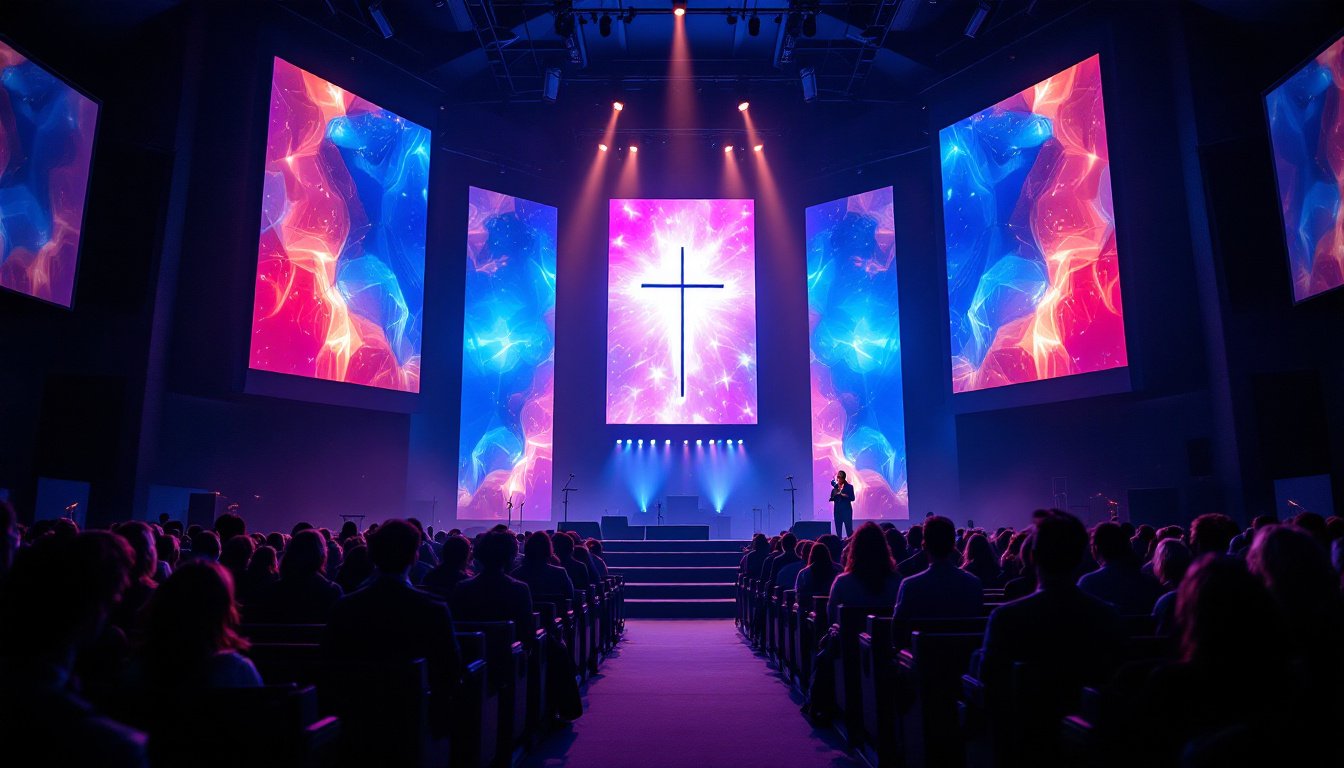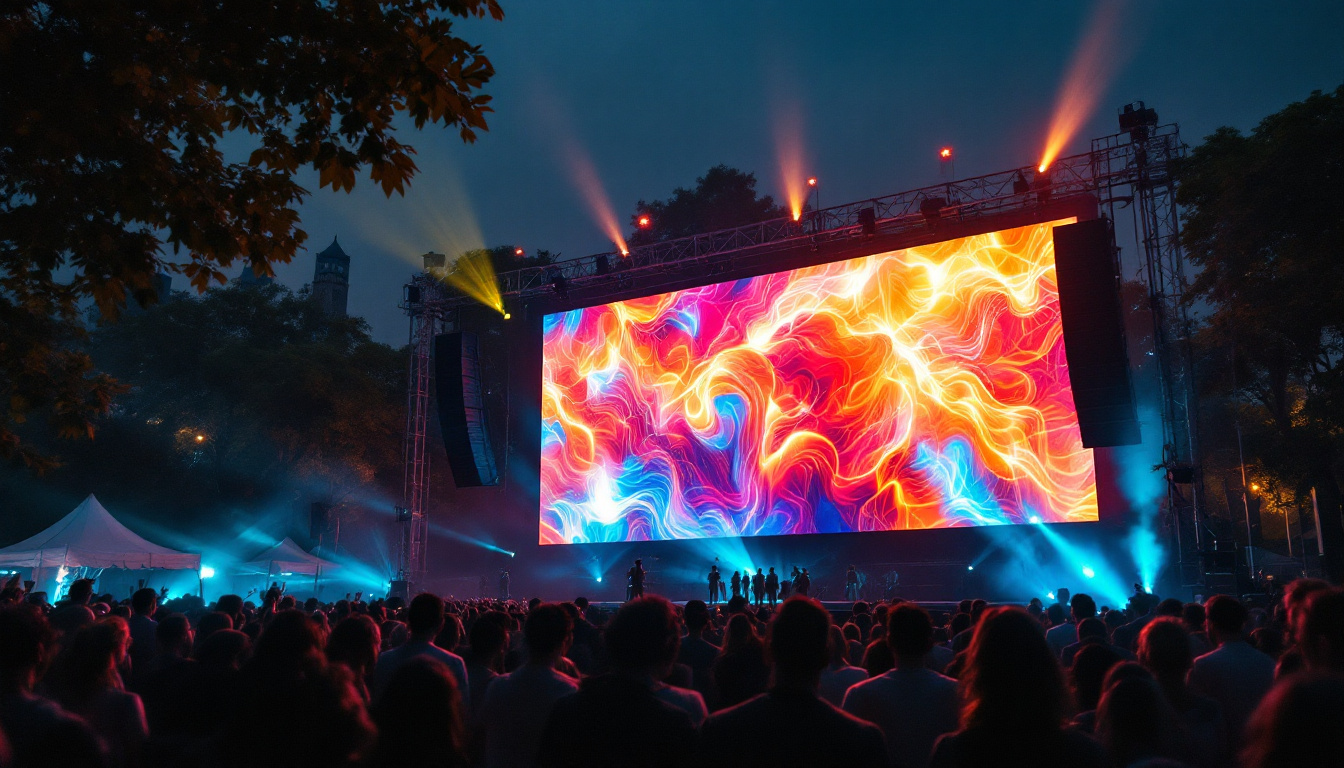In today’s digital age, the integration of technology into various aspects of life has become increasingly prevalent. One area where this is particularly evident is in places of worship, where churches are adopting LED displays to enhance communication, engagement, and overall worship experience. This article delves into the world of LED displays, particularly focusing on their application within church settings.
Understanding LED Displays
LED (Light Emitting Diode) displays are a type of electronic display that utilizes LEDs as pixels for video display. These displays are known for their brightness, energy efficiency, and versatility, making them suitable for a variety of applications, including advertising, entertainment, and, notably, religious gatherings.
How LED Displays Work
At the core of an LED display is the LED technology itself. Each pixel in an LED display is made up of tiny diodes that emit light when an electrical current passes through them. This allows for the creation of vibrant images and videos. The arrangement of these pixels can vary, with options ranging from small, high-resolution displays for indoor use to larger, lower-resolution displays for outdoor settings.
The ability to control each pixel individually enables dynamic content to be displayed, such as announcements, song lyrics, and live video feeds. This flexibility is particularly beneficial in a church environment, where the needs of the congregation can change rapidly. For instance, during a service, the display can seamlessly transition from displaying sermon notes to showcasing multimedia presentations, enhancing the overall worship experience.
Types of LED Displays
There are several types of LED displays that churches can choose from, each with its own set of features and advantages. The most common types include:
- Indoor LED Displays: These are typically used within the church building for presentations, worship services, and events. They offer high resolution and clarity, making them ideal for close viewing.
- Outdoor LED Displays: Designed to withstand weather conditions, outdoor displays are larger and brighter to ensure visibility in sunlight. They are perfect for announcements and events held outside the church.
- Mobile LED Displays: These are portable units that can be moved to different locations for special events or outreach programs. Their versatility makes them a valuable asset for churches that engage with the community.
In addition to these primary types, there are also specialized LED displays tailored for specific functions. For example, some churches may opt for LED screens that can be integrated with sound systems for synchronized audio-visual presentations, enhancing the impact of their messages. Furthermore, advancements in technology have led to the development of transparent LED displays, which can be used creatively to blend digital content with physical environments, offering a modern twist to traditional church settings. These innovative displays can transform spaces, allowing for immersive experiences that resonate with congregants and visitors alike.
Moreover, the installation of LED displays can significantly enhance community engagement. Churches can utilize these displays to share not only religious content but also community events, volunteer opportunities, and local outreach programs. By doing so, they foster a sense of connection and involvement among members, encouraging participation and collaboration. The ability to update content quickly and remotely ensures that the information shared is always current, making LED displays an essential tool for modern church communication strategies.
The Benefits of LED Displays in Churches
Implementing LED displays in a church setting offers numerous advantages that can significantly enhance the worship experience. From improved communication to increased engagement, the benefits are manifold.
Enhanced Communication
One of the primary benefits of LED displays is their ability to facilitate communication. Churches can use these displays to share important announcements, upcoming events, and service times. This real-time communication helps keep the congregation informed and engaged.
Moreover, LED displays can be utilized to display sermon notes, scripture passages, and song lyrics. This allows congregants to follow along easily, fostering a more inclusive environment. The visual aspect of these displays can also aid in retaining attention and enhancing understanding.
Increased Engagement
Engagement during worship services is crucial for a meaningful experience. LED displays can captivate the audience’s attention through dynamic visuals and multimedia presentations. By incorporating videos, images, and animations, churches can create a more immersive atmosphere that resonates with worshippers.
Additionally, interactive elements such as live polls or social media feeds can be integrated into the display, encouraging participation and fostering a sense of community among congregants. This level of engagement can lead to a more vibrant and active church environment.
Cost-Effectiveness and Energy Efficiency
While the initial investment in LED technology may seem significant, the long-term savings are substantial. LED displays are known for their energy efficiency, consuming less power than traditional display technologies. This translates to lower electricity bills for the church.
Furthermore, LED displays have a longer lifespan compared to other display types, reducing the need for frequent replacements. This durability makes them a cost-effective solution for churches looking to enhance their communication capabilities without incurring ongoing expenses.
Factors to Consider When Choosing an LED Display
When selecting an LED display for a church, several factors should be taken into account to ensure the best fit for the congregation’s needs.
Size and Resolution
The size of the LED display is crucial, as it must be visible from various points within the church. For indoor settings, a smaller, high-resolution display may suffice, while outdoor displays require larger sizes and lower resolutions to maintain visibility in bright conditions.
Resolution is equally important, as it affects the clarity of the images and text displayed. A higher resolution is essential for indoor displays where viewers are closer, while outdoor displays can operate effectively at lower resolutions due to the greater viewing distance.
Installation and Maintenance
Installation of LED displays can vary in complexity depending on the type and location. Churches should consider whether they have the necessary resources to install and maintain the display or if they will require professional assistance. Regular maintenance is essential to ensure optimal performance and longevity.
Additionally, churches should evaluate the ease of use of the display system. User-friendly interfaces can empower staff and volunteers to manage content without extensive training, making it easier to keep information current and relevant.
Content Management Capabilities
The ability to manage content effectively is a key consideration when choosing an LED display. Many modern displays come equipped with content management systems that allow users to schedule and update content remotely. This feature is particularly beneficial for churches, as it enables timely updates without requiring physical access to the display.
Churches should also consider the types of content they wish to display. Whether it’s videos, images, or text, the chosen display should support various formats to accommodate diverse content needs.
Best Practices for Utilizing LED Displays in Churches
To maximize the benefits of LED displays, churches should adopt best practices that enhance their effectiveness and ensure they serve the congregation well.
Content Strategy
Developing a clear content strategy is essential for effective communication. Churches should consider what messages they want to convey and how to present them visually. A mix of announcements, inspirational messages, and engaging visuals can keep the content fresh and relevant.
Additionally, it’s important to maintain a consistent style and branding across all content. This helps create a cohesive experience for congregants and reinforces the church’s identity.
Regular Updates
Keeping the content updated is vital for maintaining engagement. Regularly refreshing announcements, event information, and worship materials ensures that congregants have access to the latest information. This practice not only keeps the display relevant but also demonstrates the church’s commitment to effective communication.
Churches can also encourage congregation members to contribute content, such as testimonials or prayer requests, fostering a sense of community and involvement.
Training and Support
Providing training for staff and volunteers who will manage the LED display is crucial. Familiarity with the technology and content management system will empower them to utilize the display effectively. Regular training sessions can help keep everyone updated on new features and best practices.
Additionally, having a support system in place for troubleshooting and maintenance can prevent technical issues from disrupting services. Designating a point person or team responsible for the display can streamline communication and ensure that any problems are addressed promptly.
Case Studies: Successful LED Display Implementations
Several churches have successfully integrated LED displays into their worship environments, showcasing the potential benefits and creative applications of this technology.
Community Engagement through Visual Storytelling
A church in a suburban area implemented an outdoor LED display to share stories of community outreach and service projects. By showcasing images and videos of congregants participating in local initiatives, the church fostered a sense of pride and encouraged more members to get involved. The display became a central part of their community engagement strategy, effectively bridging the gap between the church and the surrounding community.
Dynamic Worship Experience
Another church utilized an indoor LED display to enhance their worship services. By integrating multimedia elements, such as live video feeds of the worship band and dynamic backgrounds, they created a more immersive experience for congregants. This approach not only captivated the audience but also encouraged greater participation in worship activities.
Real-Time Communication and Updates
A church that hosted multiple services each week adopted an LED display to communicate real-time updates to congregants. This included service changes, special announcements, and even live prayer requests. The display became an essential tool for keeping the congregation informed and engaged, particularly during busy holiday seasons.
Conclusion
As churches continue to evolve in the digital age, LED displays offer a powerful tool for enhancing communication, engagement, and the overall worship experience. By understanding the technology, its benefits, and best practices for implementation, churches can effectively leverage LED displays to create a more vibrant and connected community.
Investing in LED technology not only modernizes the church environment but also fosters a sense of belonging and participation among congregants. As more churches embrace this technology, the potential for enriched worship experiences and community engagement will only continue to grow.
Discover LumenMatrix LED Solutions for Your Church
Ready to elevate your church’s worship experience with the latest in LED display technology? LumenMatrix specializes in providing a wide array of innovative LED solutions, from Indoor and Outdoor LED Wall Displays to Custom and Transparent LED Displays, designed to captivate your congregation and enhance community engagement. Embrace the digital age and transform your church with vibrant, energy-efficient displays that speak volumes. Check out LumenMatrix LED Display Solutions today and witness the difference in visual communication and engagement.































